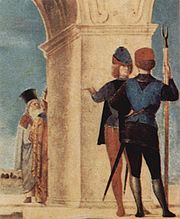.gif)
St. Sebastian (Antonello da Messina)
Encyclopedia
St. Sebastian is a painting by the Italian
Renaissance artist Antonello da Messina
, finished in 1477-1479. It is currently housed in the Gemäldegalerie Alte Meister
, Dresden
, Germany
.
One of the most famous pictures of the early Renaissance, it was once part of a triptych which was later disassembled. Until the discover of Antonello's sign, it was usually attributed to Giovanni Bellini
. The work was commissioned by the Venetian School of Saint Roch after a plague, and was completed by the Messinese painter before his death, which occurred in February of 1479.
 This picture, dominated by the vertical figure of the saint, shows a marked influence by Piero della Francesca
This picture, dominated by the vertical figure of the saint, shows a marked influence by Piero della Francesca
: this can be seen in particular in the perspective of the floor and in the "mathematical" disposition of the figurative elements. Original to Antonello is the smooth rendering of the body of St. Sebastian (defying any geometrical break-down) and the passion for the details of landscape, seen for example in Umbrian school painters like Carlo Crivelli
.
Famous details include the man reclining on the left, the typical Venetian-style chimneys, the columns and the monumental appearance of the buildings (probably inspired by some of Mantegna
's works) and the debating pairs of men on the right side, forming an interesting mixing of late Gothic
elements with Venetian
, Flemish
and advanced Renaissance
ones.

Italy
Italy , officially the Italian Republic languages]] under the European Charter for Regional or Minority Languages. In each of these, Italy's official name is as follows:;;;;;;;;), is a unitary parliamentary republic in South-Central Europe. To the north it borders France, Switzerland, Austria and...
Renaissance artist Antonello da Messina
Antonello da Messina
Antonello da Messina, properly Antonello di Giovanni di Antonio was an Italian painter from Messina, Sicily, active during the Italian Renaissance...
, finished in 1477-1479. It is currently housed in the Gemäldegalerie Alte Meister
Gemäldegalerie Alte Meister
The Gemäldegalerie Alte Meister in Dresden features major works of art. It is located in the gallery wing of the Zwinger....
, Dresden
Dresden
Dresden is the capital city of the Free State of Saxony in Germany. It is situated in a valley on the River Elbe, near the Czech border. The Dresden conurbation is part of the Saxon Triangle metropolitan area....
, Germany
Germany
Germany , officially the Federal Republic of Germany , is a federal parliamentary republic in Europe. The country consists of 16 states while the capital and largest city is Berlin. Germany covers an area of 357,021 km2 and has a largely temperate seasonal climate...
.
One of the most famous pictures of the early Renaissance, it was once part of a triptych which was later disassembled. Until the discover of Antonello's sign, it was usually attributed to Giovanni Bellini
Giovanni Bellini
Giovanni Bellini was an Italian Renaissance painter, probably the best known of the Bellini family of Venetian painters. His father was Jacopo Bellini, his brother was Gentile Bellini, and his brother-in-law was Andrea Mantegna. He is considered to have revolutionized Venetian painting, moving it...
. The work was commissioned by the Venetian School of Saint Roch after a plague, and was completed by the Messinese painter before his death, which occurred in February of 1479.

Piero della Francesca
Piero della Francesca was a painter of the Early Renaissance. As testified by Giorgio Vasari in his Lives of the Artists, to contemporaries he was also known as a mathematician and geometer. Nowadays Piero della Francesca is chiefly appreciated for his art. His painting was characterized by its...
: this can be seen in particular in the perspective of the floor and in the "mathematical" disposition of the figurative elements. Original to Antonello is the smooth rendering of the body of St. Sebastian (defying any geometrical break-down) and the passion for the details of landscape, seen for example in Umbrian school painters like Carlo Crivelli
Carlo Crivelli
Carlo Crivelli was an Italian Renaissance painter of conservative Late Gothic decorative sensibility, who spent his early years in the Veneto, where he absorbed influences from the Vivarini, Squarcione and Mantegna...
.
Famous details include the man reclining on the left, the typical Venetian-style chimneys, the columns and the monumental appearance of the buildings (probably inspired by some of Mantegna
Andrea Mantegna
Andrea Mantegna was an Italian painter, a student of Roman archeology, and son in law of Jacopo Bellini. Like other artists of the time, Mantegna experimented with perspective, e.g., by lowering the horizon in order to create a sense of greater monumentality...
's works) and the debating pairs of men on the right side, forming an interesting mixing of late Gothic
Gothic art
Gothic art was a Medieval art movement that developed in France out of Romanesque art in the mid-12th century, led by the concurrent development of Gothic architecture. It spread to all of Western Europe, but took over art more completely north of the Alps, never quite effacing more classical...
elements with Venetian
Venetian school (art)
-Context:In the 15th century Venetian painting developed through influences from the Paduan School and Antonello da Messina, who introduced the oil painting technique of Early Netherlandish painting. It is typified by a warm colour scale and a picturesque use of colour...
, Flemish
Flemish painting
Flemish painting flourished from the early 15th century until the 17th century. Flanders delivered the leading painters in Northern Europe and attracted many promising young painters from neighbouring countries. These painters were invited to work at foreign courts and had a Europe-wide influence...
and advanced Renaissance
Renaissance
The Renaissance was a cultural movement that spanned roughly the 14th to the 17th century, beginning in Italy in the Late Middle Ages and later spreading to the rest of Europe. The term is also used more loosely to refer to the historical era, but since the changes of the Renaissance were not...
ones.


